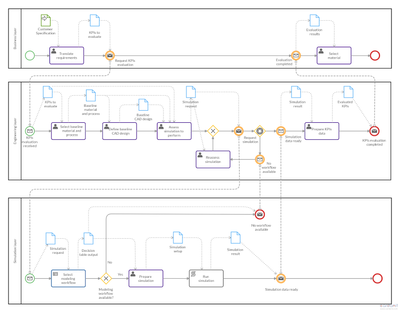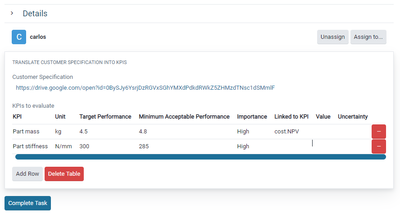BPMN and DMN: The importance of adopting the right standards in business process modeling
Written by Carlos Kavka
18 June 2020 · 9 min read

Those of you with a certain age can remember the competition during the ‘80s between two different standards for videocassettes, the VHS and the Betamax format. The younger ones may remember just the VHS, clearly indicating the winner.
We deal with standards in many daily activities and they are not restricted to electronic devices. Just think about the dimensions of the freight containers carried by ships, trains, and trucks. The standard dimensions agreed between different carriers make it easier to handle them.
More often than not, several competing standards coexist and compete. How can we be certain that we chose the right one? Does the market always get to pick the winner? It is not so easy to get a simple answer to these questions.
Indicators of a high-quality standard
In many cases, good practices become a standard just because people start to use them. However, in technological domains, standards usually arise as a consequence of official activities that are led by recognized organizations. In this case, the standard is generally specified in formal terms, published openly and maintained with activities that include public consultation, that are intended to keep the standard well updated and useful for the adopters.
In principle, we can agree that the value of a standard is in a direct proportion to its number of users. While this is a good indicator, it is not the only important aspect to consider. Economic benefits can be obtained by adopting a widely adopted standard, like the possibility to interface with already available components aiming at large scale production.
But there are also costs that must be considered before a standard adoption. Once we have selected a particular standard, there is a risk of being trapped in the technology, making it difficult to change the technical specifications of our products, with the consequence that our innovation capacity in the market is reduced.
Without any doubt, the selection of a standard must be taken seriously. It should be proposed by a well-recognized organization with demonstrated coordination abilities, with not only technological partners sitting on the board but also academics and policymakers are actively involved. And of course, the standard must be continuously maintained and updated.
Cardanit - a BPMN/DMN compliant business process editor by ESTECO
At ESTECO, we believe in standards and make strong efforts to provide our users with the best ones in our domain. To select these standards, we follow all the steps mentioned above.
To represent modeling and business processes for our BPM editor Cardanit, we have selected the Business Process Modeling and Notation (BPMN) standard. This standard has been proposed by the OMG, an internationally recognized organization that defines and promotes standards, which also took care to submit it to the International Standard Organization ISO for official approval.
However, the selection of this standard was quite a long process! We started many years ago. First, we performed an initial analysis by approaching the academic community trying to get a deep understanding of the pros and cons of the different approaches from a solid theoretical background. After many conferences and interactions with participants from academic and industrial communities, we were certain that BPMN was the right standard to follow.
While developing Cardanit, our fully compliant BPMN editor, we engaged in the MIWG group of the OMG where we continuously contribute to study interoperability aspects of the standard. We submitted to the OMG indications of problems with the standard specifications which were used in order to enhance new releases of the standard.
We currently participate every year in an OMG conference promoting the use of the standard with live demos of our products which are available on YouTube. Recently, we embraced Decision Modeling and Notation (DMN), the other standard of the OMG that nicely interfaces with BPMN, which can be used to add decision-making aspects to standard business processes.
A Business Decision Support System (BDSS) in the composite design - a bridge between engineering and business decision modeling
We are proud to say that we were the first to introduce the use of the BPMN and DMN standards in the material modeling community, where we are actively contributing to the creation of a Business Decision Support System (BDSS) for decision-making activities for polymer composites. In this activity, we are not working alone, but in strong cooperation with many research centers and industrial companies in the framework of the COMPOSELECTOR European research project.
In a previous blog post written by my college Dario Campagna, he discussed this particular use of the BPMN and DMN standards in order to represent and support decision-making activities in composite material applications. One of the most distinctive aspects of this process is that different actors with very different profiles and expertise are involved. The graphical decision process is shown below.

Even without entering in detail on the nodes or connections, a high-level view of the diagram shows that the activities are organized in three different layers, each one of them associated to the different actors which are involved in the decision process. The top layer defines the activities that are performed by business users, the middle layer the activities that engineers will be in charge of, and the lower level the activities to be performed by simulation experts.
This structure clearly reflects the fact that each class of users has to be involved only in their area of expertise: business users are involved in business decisions, engineers in engineering activities and simulation experts in areas that require their expertise to carry out simulations. Certainly, nobody will ask an expert on simulations to take a business decision or a business person to deal with simulation details.
Understanding this process represented in BPMN is not too difficult. As can be seen in the diagram, the top layer includes two activities that involve human intervention, something that is represented with rectangles with a small person-like icon on the top left corner. These two activities represent a process in which a business user follows a decision process to evaluate if a particular composite material can effectively be built by considering engineering and business constraints.
In more practical terms, the business person gets a requirement, selects and defines the Key Performance Indicators (KPIs) that are required to be evaluated (first activity) and peacefully waits for results to be provided back (second activity). After that, the business person will have all the information that is required to determine if it makes sense to proceed or not with the original requirement.
The BPMN standard is certainly quite convenient to nicely represent the process graphically. However, it can also be executed by a standard BPMN engine! In fact, when this BPMN process is executed, a business person is contacted and asked to fill a table (see below) in a nice web application. After completing the required information, the business person can just wait for the results. Of course, the business person is certainly aware that the request will involve engineers and possibly simulation experts to provide an answer for the request, but he/she is not involved at all in that process. In fact, this is the right way to proceed! The business person is an expert on business, not on engineering or simulation aspects.

The activity flow to be performed by the engineers is a bit more complex as indicated in the second layer of the diagram. Here, potentially different engineers are involved in a process where baseline materials are selected (fist activity), CAD models are created (second activity) and simulation scenarios are prepared (third activity). A request for simulations is then sent to simulation experts.
Engineers are not involved in the process any more till simulation results are ready. Only then the engineers will be involved again and will prepare the reports requested by the business experts (last activity). Please note that engineers are not involved at all in simulation aspects like determination of the HPC system to be used, disk space, memory constraints or other technical aspects. In fact, again, this is the right way to proceed! Each class of users is involved only in its own area of expertise!
The third layer, or simulation layer, is very interesting. We can see that there are three activities which have three different icons on the top left corner. As seen before, the second activity corresponds to a task that involves human interaction, but the first and third include other types of icons. The first activity (with the table icon) corresponds to a decision step represented with the DMN standard and the last one (with the script icon) to an automated task. The decision node is a special node which contains decision information that has been coded in terms of tables and diagrams defined by following the DMN standard.
In this particular example, this information is used to select automatically the best simulation workflow that can be applied to a particular simulation scenario. Based on this information, the simulation expert sets up the simulation details (second activity) and the simulation is effectively executed (third activity). Results are passed back to the engineering level when simulation has finished. Note that again here, simulation experts deal with technical aspects and are not involved at all in engineering or business details.
At the end of the execution of the process, the business person gets a message (maybe on his/her mobile) indicating that the request has been completed. He then connects to the system and gets the original table filled in the last two columns with the information that was provided by the engineers, which is in turn based on the results of the simulations that were performed by the simulation experts, as it can be seen below.

This simple example has shown that the BPMN and DMN standards play a central role in the definition of a standard process where very different classes of actors are involved, each one of them required to perform activities only in their own domain of expertise.
Standards are very important in our engineering domain without any doubt. As you could see from the previous example, at ESTECO we are very seriously contributing to their definition and promotion in our community. Since this is a collaborative process, comments and contributions from you are more than welcome to help us in following this path together.
For more information about our BPMN/DMN editor, visit the Cardanit website.
The author would like to acknowledge the support of the EU H2020 COMPOSELECTOR project (GA no: 721105). The author would like to express their appreciation to the EMMC community for many useful inputs, exchange and valuable comments. The views expressed on this paper reflect the views of the author. The European Commission is not liable for its content and the use that may be made of the information contained herein.


